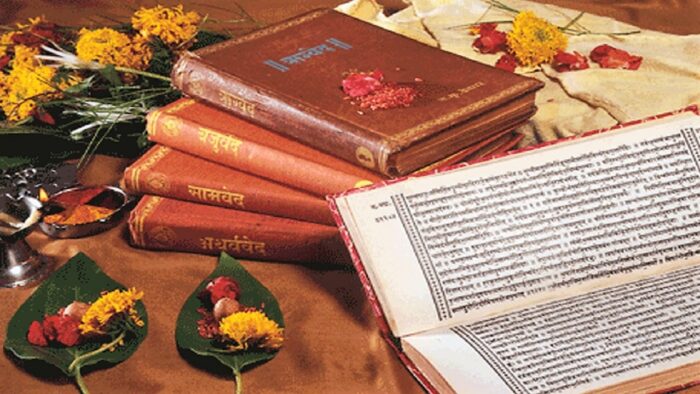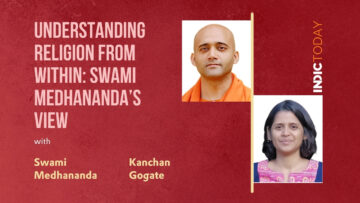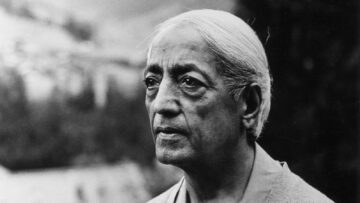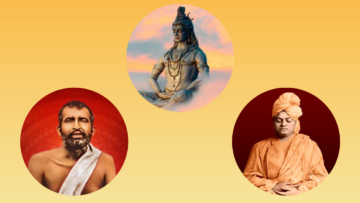Introduction:
Leaning more towards rationality and reason, the postmodern and post-colonial-era seems subverting as well as challenging religious discourse for this being less ‘logical’. Interestingly, though the authority of scriptures and priestcraft are being questioned, ‘metaphysical’, ‘mystical’ and ‘transcendental’ side of religion seems attracting scholarship in today’s time and age. After all, the highest truth cannot be subjected to withstand the test of reason and rationality of the external world, sages and masters have been claiming this for time immemorial. ‘Revelation’ of the highest truth forms the very basis of world religions, while each has chosen to express it in one’s own distinguished manner. Abrahamic or prophetic religions believe scriptures to be the final authority or the word of God while what today is known as Hinduism, roots its religiosity into Vedas, by which no books are meant. As Vedas are called revelations, this paper studies aesthetics of revelation with special reference to the word ‘apurusheyatva‘. By revelation, the word is used in the context of Indian philosophical tradition and not in a sense of biblical or any other prophetic tradition.
The transformative value of literature has been underlined time and again; nevertheless, the religious discourse has barely been extended beyond scriptures. Today, a rubric of spirituality encompasses a wide range of literature that is labeled ‘self-help’ or ‘secular’. Ancient wisdom finally gets well-conversant when it is presented in contemporary language and aligned with today’s nuances. At a macro level, this paper takes up the question if reading can become a meditative art and is intitule knowledge, which is beyond words is capable of triggering self-transformation? While various religions have attempted to answer this question, this paper tries to appropriate its methodology in literary criticism.
‘Death of the author’ marks the beginning of reader-centric debates in the postmodern 20th-century literary criticism whereas ‘Reader Response Criticism’ can be traced into Indian tradition right at the time of Vedas as they are called ‘apaurusheya’, authoress revelations. In ancient India, aesthetics was never far removed from life and contemporary literature holds a mirror to the aesthetic view of life. The primary objective of this paper is to throw light on aesthetic religion and not religious aesthetics where knowledge becomes revelation and the reader becomes the knower and the seeker. Methods of knowledge in Indian tradition are deeper and penetrative and guide seekers to understand the ‘revelations’ in the most original sense. This paper takes up the question if a modern reader/seeker can understand these ‘revelations’ in the original sense.
Methodology/framework
This paper seeks to offer a framework for interpreting philosophical Indian texts, especially Advaitic texts called Hermeneutics of Self-Inquiry. The inquiry has been an integral method in Upanishadic literature that tries to connect the reader/seeker to the internal nature. This framework is based on the Apaurusheya quality of Vedas, the Indic view of knowledge, Jnana yoga, orality tradition, aesthetic understanding of Sravana, manana, nididyasana as powerful methods to seeking/reading and reading itself becomes a meditative art. It takes clues from advaitic texts like Drig Drishya Viveka, Atma Bodha and Ashtavakra Gita, which dwell upon the seer and seen through the method of self-inquiry. The analogy of seer and seen forms the base of this framework. This framework, though located in Indian tradition, also finds parallels in reader-response criticism in western literary theory like debates of the author, reader, text and meaning, dialogical hermeneutics et al.
This paper also seeks to clarify the perspective in which it uses the word aesthetics not in a sense of poetics but grounds it in the definition of art given by philosopher, thinker Jiddu Krishnamurti, ‘art is putting everything into its right place. There is an art of seeing things as they are, without naming…[i]’ Asan example, this framework-Hermeneutics of Self-Inquiry is applied to speeches of Swami Vivekananda and J Krishnamurti. Finally, this paper acts as a rebuttal to Neo Vedantic thesis that modern interpreters deviate from the traditional reading of Advaita and proves that such a framework can lead rather to the original understanding of ‘revelation’ and not as a deviation.
Vedas as Apaurusheya revelations:
While western literary criticism seems wrestling up with the question of the author and authorial intention, Vedas are called texts by which no books are meant and Apaurusheya means impersonal. As scholar Elaine Fisher, notes, according to Mimamsa exegetical theory, the Vedas are a unique textual artifact in that they have no author, human or divine. She tries to show that at the level of reception or cognition, Vedic language as a whole provides epistemically valid access to an ontologically realist external world, and as such must be internally coherent. Because it posits this fundamental discursive unity, the Mimamsa model of the “authorless scripture,” whatever its virtues in the context of the original argument, fails to circumvent the intentional fallacy. [ii]
The notion of Apaurusheya needs to be understood with Indian philosophy in the background. In his scholarly article, ‘An Idea of Authorless Revelation’, a scholar on Indian philosophy of language Purushottam Bilimoria explains it to us. He starts with the general thesis that Indian tradition has had no personal God. [iii] The term revelation invariably entails belief in personal God and hence it needs to be understood in the context of Apaurusheya, he says. Billimoria takes up the question in the absence of personal God or other omniscient beings, how would Mimamsa account Vedas, its origin and validity? ShabdaPramana, verbal testimony is considered a means/pramanas of valid knowledge. ‘However, Vedic words are valid for the reason that they convey their own meaning and this meaning is not dependent upon some speaker or author, who might, have given personal subjectivity, err, particularly in matters religious. In short, the assertion of the validity of the Vedas is parasitic upon the very denial of the author and the intrusion of personal intentionality. The text is, as it were, “de-personalized” in respect of personal intentionality; but intentionality (tatparya) as such is not entirely eroded.’[iv]
Vedas are Apaurusheya because they are without a personal source or agent or they are without a single author or a group of authors. Vedas are the words that have been heard but not spoken what is known as Sruti literature and that’s what makes Vedas authorless. M Hiriyanna, the doyen of Indian philosophy and aesthetics, looks at Vedas as authorless because he locates it into the context of the very basis of Indian philosophy. He says that Mimamsa formalized shabda Pramana as a source of knowledge because it acknowledges the power of words/revelations to express intuitive knowledge… Hiriyanna tries to show that Sruti is a social tradition and Vedas are Apaurusheya in the sense that the highest revelations or truths must be made public and not remain personal.[v]
Bilimoria demonstrates that revelation is not necessarily God’s revelation as faith presupposes God and God is necessary for revelation. He goes on substantiating this quoting a famous India philosopher J N Mohanty. The Apaurusheya doctrine then becomes a part of the defense of the claimed ahistoricity of the textual tradition and the Vedas are proclaimed by orthodoxy to be atemporal, ahistorical and non-originated’. [vi]This traditional approach liberates Vedas from individual intentionality because Bilimoria claims ‘language is prior to experience’.
As many scholars have tried to understand the notion of Apaurusheya and revelation in the context of Mimansa theory or language and Shabda Pramana, the notion of authorless revelation fids more consolidation as there is no personal/authorial intentionality and authority. The philosophy of language expounds that speech is prior to language. The autpattika sutra of Jaimini says that the correlation between shabda and artha is originary. Bilimoria points out that this autpattika thesis has parallels in Saussure’s about the integral union of the signifier [significant] (a sign-vehicle) and the signified [signifie] (meaning) in any system of signs. It means that the relation between Shabda and artha cannot be attributed to any individual. In this sense, it is, non-originative. Metaphysics revealed in scriptures is more important than the origin of scriptures and Bilimoria suggests that ‘the feasibility of talk about revelation without a revealer or an author and it does this by trying to show that scriptures, texts, indeed language, need not be a function of an author, speaker or subject. It grounds intentionality, otherwise attributed to the author or subject, in the givenness of language itself. Beyond this, there is no other presence. To me, the notion of Apaurusheya suggests the possibility of an Ultimate Absence, with a remainder.’[vii]
In his book ‘Reason and Revelation in Advaita Vedanta’, author K Sachidananda Murty offers fourfold Advaitic reason of Apaurusheya, i) According to Vachaspati, words uttered by no two cannot be identical. There is no independent author of veda ii) Statements that come from the speaker/opinions are Paurusheya. Vivarana school says that that purport of Vedas is not to express an opinion, not even that of God, its purpose through an injunction to study consists in injunctions’ iii) Absence of human utterance makes it Apaurusheya as Brahman and not a person is the cause of Vedas, says Sayana in his commentary) iv) Vedanta Paribhasha: Between creation and dissolution, Veda remains without generation and destruction.[viii]
Apaurusheya: Modern theology in making?
Modern scholars like Francis X Clooney or V K Chari have been making ground-breaking attempts to bring Mimansa textual exegesis in dialogue with modern discourse. Clooney says theological studies no more center around questions about the nature of God, the revelatory capacity of Scriptures, or the explanation of religious experience in ways satisfying to the contemporary mind.[ix] Clooney says that scholars now ask: “What kind of theology can be done after the death of God? How does one determine and organize the meanings of a sacred text without appealing to the idea of an author who establishes meaning?” He seems to be indicating that Vedas have answered it to an extent thousands of years ago. On the basics of early Mimansa (as Clooney prefers to call Purva Mimmansa), 1) religion includes meanings and values appropriate to human beings, but the sum of its meaning necessarily exceeds the human perspective; 2) the sacred Sanskrit-language Scripture known as the Veda is not a “book” to be read, nor a source of information about a world exterior to itself; and 3) the Veda has no author, no meaning beyond the words and the sacrificial actions themselves; one cannot appeal to a pre-verbal intention to get beyond the words.[x]
Clooney’s explanations of the last point give us many hints on why Vedas are authorless. Like Bilimoria, he also expounds this Apaurusheya quality with Mimamsa’s philosophy of language. He says that in a sacrifice, sacrificer is an instrument, neither the creator nor of rites nor their finality. Similarly, the Veda has no creator, no author. People do not invent their rituals, nor author their sacred texts, says Mimamsa’[xi]Clooney says that in the case of the human author, it will make Vedas as infallible as humans are and in case of divine authors, their intention cannot be expressed perfectly in human language. ‘The Veda in effect uses the instrumentality of an “author” to express itself.’[xii]
Clooney says that this authorlessness of Vedas and underlying concern of liberating sacred texts from the author resonates with The Mimansa theory of authorlessness, with its underlying concern to “liberate” the sacred texts from its author, approaches Michel Foucault’s influential interpretation of the common (though not universal) way in which the author-function is used as a societal tool to restrain language, assign responsibility, and confine the meaning of texts. [xiii]
Hermeneutics of Self inquiry
This paper seeks to offer a framework for interpreting modern Indian philosophical texts. The framework called Hermeneutics of Self-inquiry particularly offers a methodology to understand or interpret the speeches of Swami Vivekananda and J Krishnamurti. Centered around the idea of authorlessness or Apaurusheya quality of Vedas, this framework will be based on Indian philosophy of language, Shabadaand Anubhava as Pramanas and trying to bring the methods of knowledge Jnana yoga and Advaita Vedanta under the purview of literary criticism. Can reading become a meditative experience and trigger self-transformation? The idea is not to answer this question but to stay with it and inquire. As Advaita Vedantic inquiry is based on ‘Who am I’, this framework uses Advaita Vedanta praxis and methodologies and brings it in dialogue with literary criticism. The methods of Sravanam Manana and Nididyasana can themselves be applied to meditative reading. This paper doesn’t intent to underestimate other meditative practices advocated by Advaita Vedanta or practical spiritual training but tries to understand how Upanishadic inquiry can lead us to the path of self-transformation and role of spiritual literature in it.
While modern researchers are talking about reading as awareness or meditation, this framework provides a way to a right understanding of Jnana yoga or Buddhist texts. The framework explores if readers can become seekers. Indian orality or textual tradition has already liberated its texts from personal authorship; therefore, the idea of revelation comes on ‘what is being said that who said it’. Western literary criticism is talking about reader-oriented theories, Indian orality tradition targets readers and keeps its takes as ‘authorless’ or impersonal as possible. Advaita Vedanta talks about realizing self as a brahman. It calls self/brahman as one without the second and realizing that truth of self. Advaita texts give methodologies to understand intrinsic oneness. Jnana yoga puts the question, what it is worth knowing, knowing thyself or the external world? This framework helps seekers/readers contemplate over it and inquire. Again with the hard problem of consciousness talking about the inability of science to understand reality or existence, Advaita takes us back to the understanding that knower cannot be the object of knowing. Similarly, philosophy of language, all over the world, has spoken about the inability of words to express this ‘highest truth’, revelations are just signifiers, pointers. As Vivekananda has eventually given us the empirical approach that if the highest truth of religions exist, I must know it. This framework considers the experiential/intuitive approach in Advaita Vedanta.
This framework focuses on the speeches of Swami Vivekananda and J Krishnamurti, who had radically different approaches to tradition. However, both spoke about self-transformation turning inward or transformation that is not dependent on time and method. Swami Vivekananda is exclusively talking about the Upanishadic wisdom; however, he treats Advaita as the religion of tomorrow, in the age of rationality and reasoning. He talks about the potential divinity of man which can find manifestation through karma, Raja, Bhakti, and Jnana yoga. This study claims that Vivekananda’s rereading of Advaita deserves more critical and scholastic attention. His speeches and letters have given us the hint on choosing the best of the scriptures and discarded all that is sectarian.
On the contrary, Jiddu Krishnamurti repudiated connections with organized religions and philosophies and invited his audience to investigate the problems of everyday living. Steering clear of systematizing his teachings, Krishnamurti wanted us to see, observe and listen to ‘what is’. He has also spoken on the limitations of language and thought in to understand ‘what is’! The framework would be considering this investigative insistence in inquiring into self.
Advaitic self-inquiry
Advaitic self-inquiry is a Jnana yoga method of realizing who you really are and knowing your true nature. Jnana yoga is more about discriminating our true self from the illusion, maya, differentiating between the real and unreal. This is prominently seen in Shankaracharya’s writings and other non-dualistic texts like Adhyatma Ramayana, Ashtavakra Gita, Avdhoot Gita, et al. Self-inquiry has been popularized by 20th-century mystic Ramana Maharshi who advocated his seekers to inquire into who am I?
Brahman is the central figure and self-inquiry is aimed at understating self as a Brahman. Francis X Clooney explains to us what makes an Advaita reader, the one who wants to know the truth about Brahman. ‘The successful reader, to be able to be persuaded that there is a single meaning to the Upanishads, the brahmanis the focus of that meaning, and that this Brahman is the sole cause of the world, is a reader who is -or who is becoming-literature and cultured in an Advaita way.’ [xiv] About Advaita reader, he says Merely passive or merely receptive readings are excluded; ‘reader as the observer is replaced by the reader as participant’. [xv]Clooney brings our attention to the methodology of Advaita as Jijnanasa, desire to know while Mimamasa is investigation and Vedanta of which Advaita is a sub-school. He says we must trace geology of that reader in the textually mediated desire for brahman (Brmahjijanasa).
The knowledge that Advaita talks about is not the knowledge of the external world. It’s a true knowledge of self. The process of Self-inquiry is so simple that it can be explained in a few words. One traces the root of one’s thoughts back to the I-thought, from which all other thoughts arise and diverge. This is initiated by the question “Who am I?” or similar questions about one’s true identity.
David Frawley notes that Self-inquiry requires that we have a fundamental doubt about who we are that rejects all outer identifications. ‘True Self-inquiry is not just questioning the limitation of our outer identity, like our family, political or religious affiliations – whether one is a wife, a father, a Christian, Hindu or communist. It questions our internal identity as an embodied being and as a mind. It does not stop short with some general identity as a human, cosmic or spiritual being but rejects any formation of thought. It directs us back to the pure “I” that has no identity with any form of objectivity, physical or mental, that is in the world but not of it. The True Self is not only beyond human distinctions, it is beyond all conceivable divisions of time and space, name and form, birth and death. It is beyond all experience as the experiencer or observer of all. Self-inquiry leads us ultimately to the experience of the Absolute in which the phenomenal world becomes little more than a mirage of the mind and senses. It goes far beyond the discovery of some greater self, human or creative potential. It is called the direct way to the Absolute.’[xvi]
Investigating to nature of seer and seen:
Drig-Drishya-Viveka ,a Sanskrit text often attributed to Sri Shankaracharya or sometimes to Vidyaranya, investigates into the nature of seer and seen. It’s about understanding the true nature of self, here and now. It gives a very basic gist of Advaita philosophy that self-realization is here and now as it’s not a journey into space and time. It’s a journey from ignorance to knowledge. Advaita says we are making a serious mistake to consider ourselves as body and this path of self-inquiry is investigating into true nature. It expounds on the analogy of Upanishads of three states; waking, dreaming and deep sleep; and true experience is beyond. The very analogy Drig Drishya Viveka means discerning the seer from the seen. Swami Sarvapriyananda, a scholarly monk of Ramakrishna Math and Mission, in his discourse on Drig Drishya Viveka calls it a yoga of self-inquiry. [xvii] He relates it to Jnana yoga methods Sravana, manana and Nididyasana. First comes hearing about what I am, then comes contemplating thinking and Nididyasana is meditating over it. He says that there is nothing esoteric about this self-inquiry method rather it’s just a deeper investigation to understand self or seer as the witness consciousness.
He brings our attention to the fact that our mind, body and thoughts are objects of consciousness, through which we perceive reality. But the true self is not an object. Drishya is changing continuously but drahsta doesn’t. That awareness consciousness is different from mind and body and understands changes in mind and body. The object is different from the subject and seen is different from the seer. The seer that self is a witness consciousness, pure awareness and self-luminous in the light of which everything gets illumined. Awareness cannot get aware because it’s not an object. It’s pure knowledge it cannot know because it is knowledge itself.
Swami Nikhilananda, in his translation of Drig Drishya Viveka, says ‘Drig Drishya Viveka, as the name indicates, is an inquiry into the distinction of the ‘Seer ‘ (drig) and the ‘ Seen ‘ (Drishya) an inquiry which is of the utmost importance for the understanding of the higher Vedanta Philosophy. Drig Drishya Viveka, in dealing with certain aspects of the subject matter, follows a method which may be called rational in that it attempts to discuss by employing a method which is known in logic as the method of Agreement and Disagreement or the method of Anvaya Vyatireka of the Indian Nyaya system.’[xviii]
This method of the seer and seen is a kind of philosophical inquiry. Therefore, Hermeneutics of Self-Inquiry can be a philosophical as well as a literary method to understand ancient wisdom in new light.
Conclusion
This paper proposes that Indian philosophy offers many clues that would be essential for understanding sacred texts in modern times. Every concept of Apaurusheya talks about not just aesthetics in the sense of art and literature but aesthetics of cosmology, the purpose of the universe and eventually, human life. This paper expounds on the method of Hermeneutics of Self-Inquiry, philosophical inquiry appropriated under literary criticism that can help decode spirituals texts beyond agamas into original light and can also pave way for future fields of studies in the philosophy of language, the epistemology or theory knowledge, author-reader debates, power of transformation of literature and consciousness studies.
[i] Krishnamurti J(1973), Flight of the Eagle, Krishnamurti Foundation Trust
[ii]Fisher, Elaine. (2008). “A Book with No Author: Does Mimamsa. Circumvent the Intentional Fallacy?” Journal of Indian Philosophy, vol 36 (2008). pp. 533–542
[iii]Bilimoria, Purushottama. (1989). On the Idea of Authorless Revelation (Apaurusṣeya). 10.1007/978-94-009-2458-1_10.
[iv] Ibid 148
[v]Hiriyanna, M. (1973). Outlines 01 Indian Philosophy. Bombay: George Allen & Unwin p.28
[vi]Mohanty, J.N. (1982) “Indian Philosophy Between Tradition and Modernity”. In S.S. Pappu Rama Rao & R. Puligandla (eds.), Indian Philosophy Past and Present. Delhi: Motilal Banarsidass p. 237
[vii] Bilimoria p. 165
[viii] Murty Sachidananda K (1959), Revelation and Reason in Advaita Vedanta, New York Colombia University press pg. 44 to 49
[ix]Clooney, F. X. 1. (1987). Why the Veda has no author: Language as a ritual in early Mīmāṃsā and post-modern theology. Journal of the American Academy of Religion, 55(4), 659-684
[x] Ibid
[xi] Ibid 672
[xii] Ibidp. 674
[xiii] Ibid Pg. 675
[xiv]Clooney Francis X., SJ, (1993), “Theology After Vedanta An Experiment in Comparative Theology”, Sunny Press,
[xv] Ibid
[xvi] Frawley David aka Vamadeva Shastri, ‘Self Inquiry and its practice’ https://www.vedanet.com/self-inquiry-and-its-practice/
[xvii]https://www.youtube.com/watch?v=4mmVQiUqQ3U&t=1064s
[xviii] Nikhilananda Swami (1931), Drig Rishya Viveka, Ramakrishna Mission Ashrama Mysore,
image credit: vedicmatters.com
Conference on Hindu Aesthetics
Watch video presentation of the above paper here:
Disclaimer: The opinions expressed in this article belong to the author. Indic Today is neither responsible nor liable for the accuracy, completeness, suitability, or validity of any information in the article.











